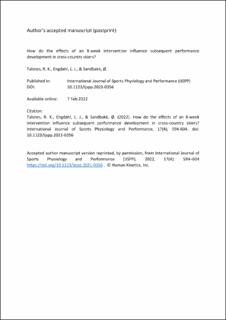| dc.contributor.author | Talsnes, Rune Kjøsen | |
| dc.contributor.author | Engdahl, Lars Jonatan | |
| dc.contributor.author | Sandbakk, Øyvind Bucher | |
| dc.date.accessioned | 2023-06-20T11:19:22Z | |
| dc.date.available | 2023-06-20T11:19:22Z | |
| dc.date.created | 2022-02-25T12:44:21Z | |
| dc.date.issued | 2022 | |
| dc.identifier.citation | Talsnes, R. K., Engdahl, L. J., & Sandbakk, Ø. (2022). How do the effects of an 8-week intervention influence subsequent performance development in cross-country skiers? International Journal of Sports Physiology and Performance, 17(4), 594-604. doi: | en_US |
| dc.identifier.issn | 1555-0273 | |
| dc.identifier.uri | https://hdl.handle.net/11250/3072276 | |
| dc.description | Author's accepted version (postprint). | en_US |
| dc.description | This is an Accepted Manuscript of an article published by Human Kinetics in International Journal of Sports Physiology and Performance (IJSPP) on 7/2/22. | en_US |
| dc.description | Available online: doi.org/10.1123/ijspp.2021-0356 | en_US |
| dc.description.abstract | Purpose: To investigate how the effects of increased low- vs. high-intensity endurance training in an 8-week intervention influenced the subsequent development of performance and physiological indices in cross-country skiers. Methods: Forty-four (32 men and 14 women) junior cross-country skiers were randomly assigned into a low- (LITG, n=20) or high-intensity training group (HITG, n=24) for an 8-week intervention followed by 5 weeks of standardized training with similar intensity distribution, and thereafter 14 weeks of self-chosen training. Performance and physiological indices in running and roller-ski skating were determined pre-intervention, after the intervention (POST-1), and after the standardized training period (POST-2). Roller-ski skating was also tested after the period of self-chosen training. Results: No between-group changes from pre-intervention to POST-2 were found in peak speed when incremental running and roller-ski skating (P=0.83 and 0.51), although performance in both modes was improved in LITG (2.4% [4.6%] and 3.3% [3.3%], P<0.05) and in roller-ski skating for HITG (2.6% [3.1%], P<0.01). While improvements in VO2max running and VO2peak roller-ski skating were greater in HITG than LITG from pre-intervention to POST-1, no between-group differences were found from pre-intervention to POST-2 (P=0.50 and 0.46), although VO2peak roller-ski-skating significantly improved within HITG (5.7% [7.0%], P<0.01). No changes neither within nor between groups were found after the period of self-chosen training. Conclusions: Differences in adaptations elicited by a short-term intervention focusing on low- vs. high-intensity endurance training had little or no effects on the subsequent development of performance or physiological indices following a period of standardized training in cross-country skiers. | en_US |
| dc.language.iso | eng | en_US |
| dc.publisher | Human Kinetics | en_US |
| dc.title | How do the effects of an 8-week intervention influence subsequent performance development in cross-country skiers? | en_US |
| dc.type | Peer reviewed | en_US |
| dc.type | Journal article | en_US |
| dc.description.version | acceptedVersion | en_US |
| dc.rights.holder | © 2022 Human Kinetics, Inc. | en_US |
| dc.source.pagenumber | 594-604 | en_US |
| dc.source.volume | 17 | en_US |
| dc.source.journal | International Journal of Sports Physiology and Performance (IJSPP) | en_US |
| dc.source.issue | 4 | en_US |
| dc.identifier.doi | 10.1123/ijspp.2021-0356 | |
| dc.identifier.cristin | 2005479 | |
| dc.relation.project | The Research Council of Norway: 298645 | en_US |
